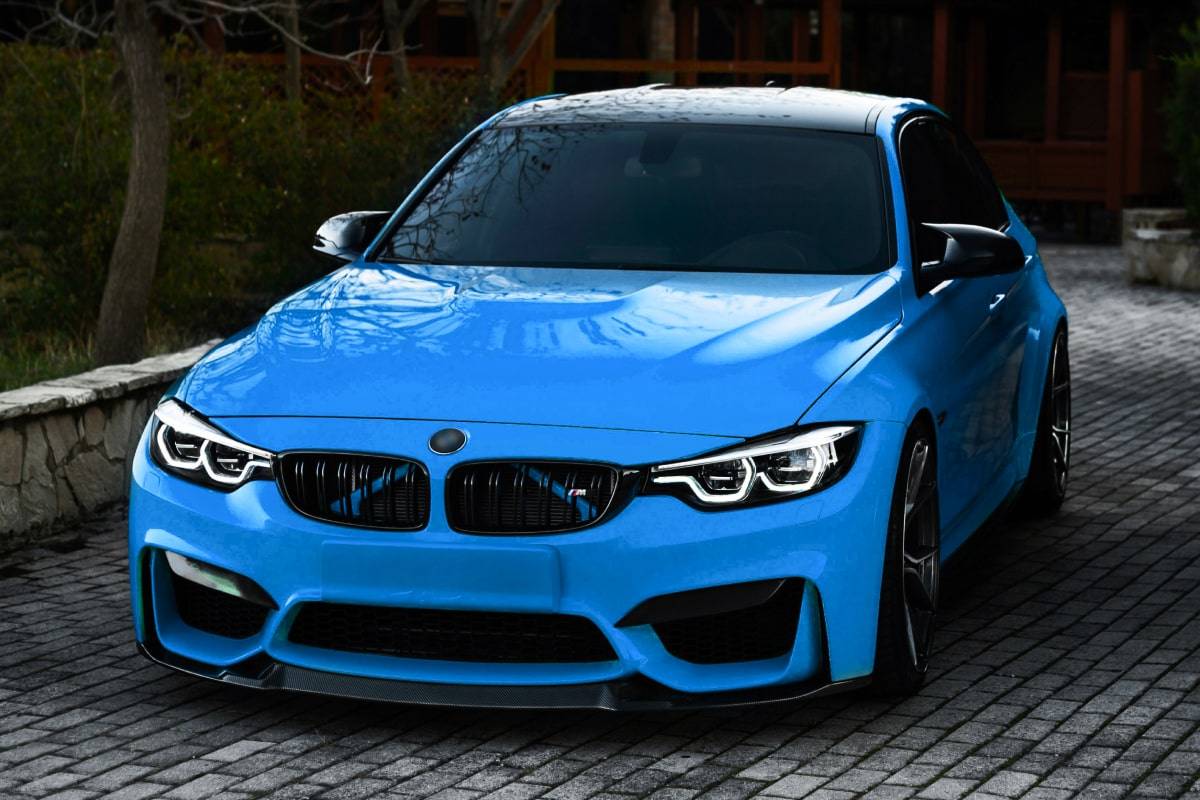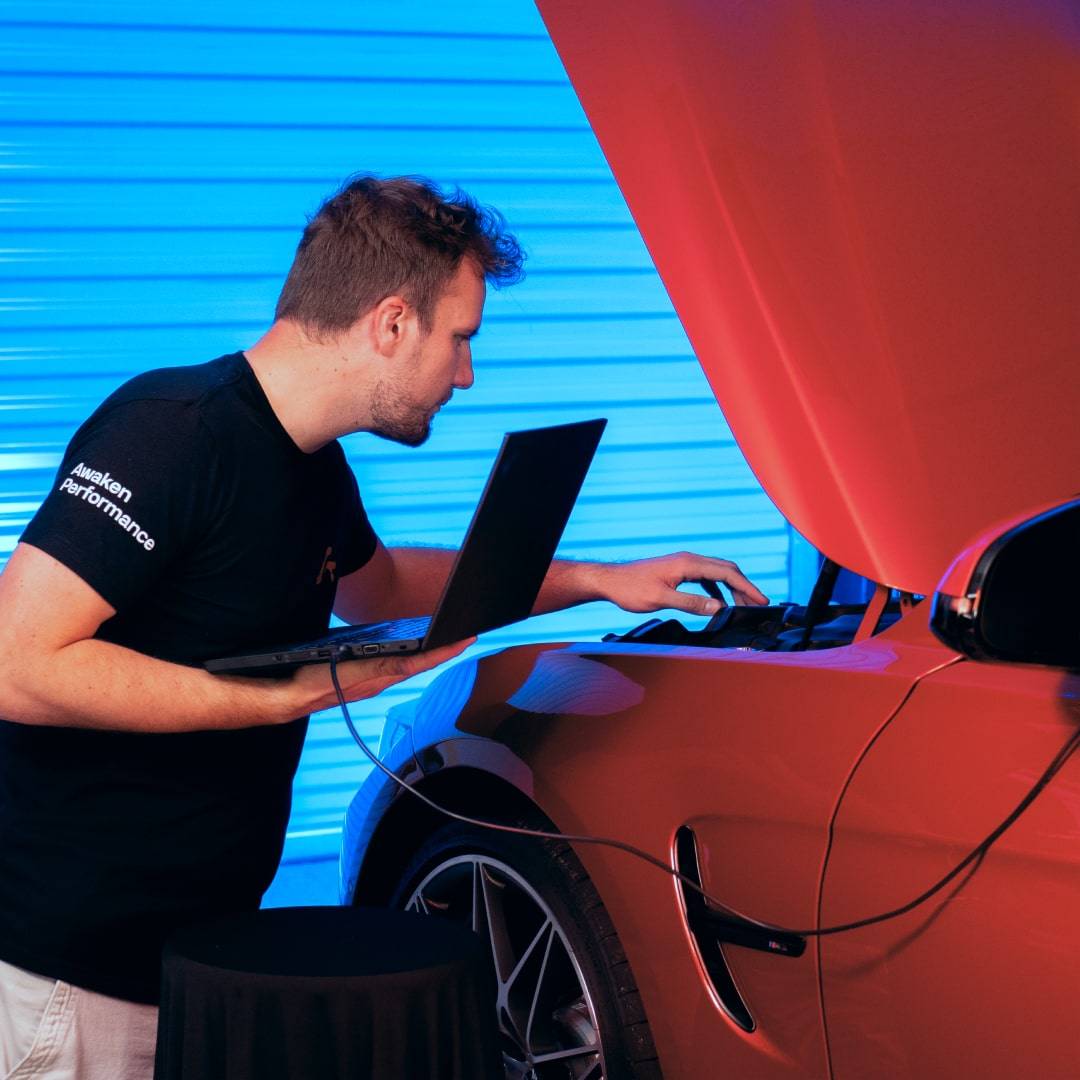[[post.title]]
Feb 27, 2024

Imagine going from 425 to 545 hp in your BMW M3 all while maintaining its reliability…
Doesn’t seem probable? Well, just keep on reading and see for yourself! Since we’re constantly working on improving our product lineup, testing is only a natural part of this development process. And when it comes to ECU tuning testing, it often results in a whole lot of data we can all geek out about.
So, based on the popular demand expressed in our customer surveys, we’ve decided to provide you with a behind-the-scenes look at some of the figures involved in the Awaken Performance BMW Engine Tuning service.
In this article, we’ll take a detailed look at the BMW S55 engine tuning and show you other equally important advantages an ECU tune can introduce in your car (spoiler alert: you won’t fear gas station visits anymore!). Without further ado, it’s time to dive in.

Before we discuss the findings of our testing, some technological context is required.
For that, let’s quickly move back to the year 2009, when the BMW N55 was introduced. A replacement for the Bavarian’s first mass-produced turbocharged gasoline power plant (BMW N54), the N55 formed the foundation for the BMW S55 engine, which then became the first widely-used turbocharged engine of the BMW M division.
That’s a lot of firsts, so here’s a simple chronological recap:
If you are interested in a detailed history of the abovementioned designs, be sure to check out our article about BMW N54 and N55 engines. Coming back to the BMW S55 engine, you might be wondering: “What makes it better suited for performance applications than the N55?”
Well, glad you asked!
Similar to its regular roadgoing counterpart, the BMW S55 is a turbocharged inline-six engine with 3.0 L of displacement and a direct fuel injection system in place. Both of them use variable valve lift and timing (Valvetronic and double VANOS respectively). As you probably guessed, the differences between the two boil down to the strength of the internal components.
The S55 uses a hefty closed-deck engine block, a lightweight crankshaft with strengthened bearings, more durable pistons and piston rods, and it employs stronger materials overall. Changes also include revisions to the entire cooling system as well as the addition of an extra fuel pump and turbocharger for a total of two each.
This results in the BMW S55 achieving up to 453 hp and 443 lb-ft (601 Nm) of torque in the range-topping M3 CS. That’s an almost 25% increase over the top output the N55 can put out at 365 hp and 343 lb-ft (500 Nm).
What cars and variants did the S55 come in?
| Power & torque figures: | Fitted to: |
| 405 hp & 410 lb-ft (555 Nm) | 2019–2021 BMW M2 Competition (F87) |
| 425 hp & 406 lb-ft (550 Nm) | 2014–2018 BMW M3 (F80) 2014–2020 BMW M4 (F82/F83) |
| 444 hp & 406 lb-ft (550 Nm) | 2016–2018 BMW M3 Competition (F80) 2016–2020 BMW M4 Competition (F82/F83) 2020–2021 BMW M2 CS (F87) |
| 453 hp & 443 lb-ft (601 Nm) | 2018 BMW M3 CS (F80) 2017–2020 BMW M4 CS (F82) |
| 493 hp & 443 lb-ft (600 Nm) – a specially modified variant with a water injection system | 2015–2016 BMW M4 GTS (F82) |
There is one caveat regarding the numbers above – they are just the factory claims.
It’s newer, it’s more powerful, and it’s also more reliable. So yes, the BMW S58 engine is the better of the two. It doesn’t mean that the S55 is bad though. The former was designed as a replacement and an IMPROVEMENT of the older engine, so obviously it builds upon BMW’s experience with the S55. But how do they compare to one another?
They are somewhat similar in that:
…At the same time, there are also certain things they do differently, like:
All of these design changes result in the S58 producing 460 to 560 hp and 406 to 479 lb-ft of torque in its stock form. Since it’s a current go-to engine of the mid-tier BMW M models, you can find it in cars like the BMW M3 (G80), BMW M4 (G82), BMW X3 M (F97), or BMW X4 M (F98), along with their Competition variants.
As you can see, the more modern BMW S58 is a robust, overengineered beast of an engine. We say “overengineered” because the S55 is plenty reliable and has a proven track record of being one of the more dependable M engines. So don’t beat yourself up for choosing a car powered by it – we are certain you’ll enjoy it for a long time.
Getting back to what we said about the “factory claims” – they are called claims for a reason. You see, vehicle manufacturers aren’t really that reliable when it comes to informing their customers about the power and torque outputs of their cars.
Since auto sales are all marketing, they want to attract potential buyers with pretty much anything they can think of. Enter the spec sheets and colorful brochures, where the pissing contest starts. That’s why the car makers often provide the so-called crank or brake horsepower numbers (chp or bhp respectively) in their spec sheets. The figures you could, theoretically, measure right at the crankshaft.
However, take your ride to a dyno where the wheel horsepower is measured (whp) and you’ll frequently find out that what your car puts down to the asphalt is… less impressive. Where does that discrepancy come from?
The answer is simple: the drivetrain loss.
…And the fact that the manufacturers want to showcase the bigger number. Before the horsepower and torque reach your wheels, they have to go through the transmission, driveshafts, and differential(s). All these moving parts, all these direction changes soak some of the “juice” in. Exactly how much power and torque is lost along the way?
Well, that depends on many factors. Is it an all-wheel drive car? Are we talking about a performance vehicle with heavy, robust driveshafts? Does it have a manual or an automatic transmission? There are some rule-of-thumb drivetrain loss calculation methods, but they in no way guarantee accurate results. In general, it should oscillate around 10–25%, depending on the drive type (front-, rear-, or all-wheel drive).
Unfortunately, the information specifying which type of power measurement unit was given in the official data is almost never there. This means that comparing figures between various manufacturers is like comparing apples to oranges – pretty much pointless.
The above is not the case at all with BMW. What they include in the specifications frequently matches the whp readouts from a dyno. Better yet, sometimes you’ll have bimmers pumping out significantly more wheel horsepower than the factory claims. In their stock form, of course.
With power and torque figures being all over the place in BMWs, when we set out to gather some reliable data for your entertainment, we knew a visit to the dyno was necessary. Which brings us to the main course of this article: exploring our BMW S55 engine test results!
 Let’s start this technical part by introducing the main character of this story. As the headline suggests, it’s a 2014 BMW M3 (F80) in Alpine White with a seven-speed dual-clutch transmission and the S55B30T0 engine. Stock it should be making 425 hp (317 kW) and 406 lb-ft (550 Nm) of torque. Since it’s already been established that BMW claims cannot be trusted, we went ahead and tested the car on a real Dynojet dyno.
Let’s start this technical part by introducing the main character of this story. As the headline suggests, it’s a 2014 BMW M3 (F80) in Alpine White with a seven-speed dual-clutch transmission and the S55B30T0 engine. Stock it should be making 425 hp (317 kW) and 406 lb-ft (550 Nm) of torque. Since it’s already been established that BMW claims cannot be trusted, we went ahead and tested the car on a real Dynojet dyno.
The results? As per our readouts, this particular BMW F80 produced 417 hp and 412 lb-ft (around 559 Nm) of torque at the wheels. In its bone-stock format. So it’s just 8 hp short of the manufacturer’s claims, but 6 lb-ft over the claimed torque.
Fast forward around an hour into the future and a straightforward tuning session off of the dyno, and we’re now back to testing the same car with a vastly different ECU map. One quick note: our Awaken Performance BMW engine tune is designed with everyday usability and reliability in mind.
That being said, even its conservative nature allowed us to reach an impressive 464 whp and 532 lb-ft (721 Nm) of torque. When it comes to the power and torque at the crank, this should translate to approximately 546 hp and 625 lb-ft (847 Nm). That’s around 11.3% more for the whp and 29.1% more for wheel torque than with the stock ECU tune.
Along the way, we also logged the car before and after for some additional research data. One of the most important findings of our logging was the significant drops in engine coolant and operating temperatures. On average, our test BMW F80 was running around 25% cooler for both of these parameters, with a decrease from 225°F to 179°F, which translates to 107°C and 82°C respectively for our metric friends.
Before we explain why lower operating temps are a great thing (for those of you who might not know), here’s a quick recap of our Awaken Performance BMW F80 engine tuning session.
| PARAMETER | BEFORE THE TUNE | WITH AWAKEN PERFORMANCE |
| Power | 417 whp | 464 whp |
| Torque | 412 lb-ft (559 Nm) at the wheels | 532 lb-ft (721 Nm) at the wheels |
| Coolant & operating temp. | 225°F (107°C) | 179°F (82°C) |
Numbers presented above are cool and all, but how does all of that translate to your car? Especially if you’ve got a regular non-M BMW or if yours is powered by a different powertrain. Luckily, we’ve got answers to these questions too!
The answer is “yes.” Or rather “it translates,” but let us elaborate.
Long story short, you will also experience improvements in the same (and more!) areas with our Awaken Performance tune. Now we cannot guarantee the exact same percentage of power and torque gains or temperature drops, however, you’ll definitely feel the difference – that we can actually guarantee.
You can expect changes in the following areas.
While all of the figures quoted above are backed by our actual research, there is one important thing to note. We cannot guarantee that after getting our BMW ECU tune you’ll get the very same improvements in your car. The engine performance is affected by many external factors, such as the ambient air temperature and humidity, the elevation above sea level, engine condition, and fuel quality.
These, in turn, will affect how much your car is pumping out in terms of power and torque, which could result in different dyno readouts than what we presented in this case study. This means that it’s equally possible for your BMW to match these figures, as it is for it to produce more or less whp. The same goes for the mileage improvements – in this instance though, your driving style will be another important variable ;)
But what if you actually wanted to go ahead and tune your car with us…?

So here’s the deal: we wanted to make the BMW tuning experience as convenient and straightforward as possible for you, our customers. That’s why we prepared an entirely remote package, which can be installed without you leaving your driveway. No, you won’t have to visit a specialized tuner workshop that has a dyno.
The list of things you’ll need isn’t long:
What are the steps of the Awaken Performance tuning process?
What’s even greater about our method than its simplicity is that we’re offering it with a Money-Back Guarantee! So if you decide the tune doesn’t satisfy you, we’ll reinstall your stock ECU map and do a full refund – bringing both your car and your wallet to the state from before the engine tuning.
Okay, but there must be some catch to all that greatness, right? Nope, it’s all true. However, there are some considerations you should keep in mind…
First of all, the most important thing is that your car should be well-maintained before you have it tuned anywhere, be it with our Awaken Performance or somewhere else. Period. A good ECU remap will make your engine operate at lower temperatures and therefore extend its longevity. But if there are some hidden faults or engine malfunctions, the tune will increase the failure risk.
Second, don’t forget to maintain your car regularly after the tune. Change your motor oil and filters on time using high-quality products. It’s also good to inspect your spark plugs from time to time and replace them if necessary. When it comes to feeding your car, reach only for the highest quality fuels available to you and match or exceed the octane rating specified when ordering the tune.
We strongly recommend using gasoline with a minimum octane rating of 93 (AKI for the US) or 98 (RON for most other countries worldwide). If premium gas isn’t readily available in your area, we also have slightly more conservative tunes for the lower ratings – let us know before placing your order.
Additionally, in the case of the BMW S55 you should note that if you want to achieve maximum performance, you’ll need to either narrow your spark plug gaps or swap your plugs for ones with smaller gaps.
There’s no denying that the S55-powered BMWs are already very potent in their stock format. While chasing seemingly “unlimited” power and torque gains is a slightly pointless goal in itself, high-performance cars like that can greatly benefit in other areas. We’re talking about vastly improved responsiveness in everyday driving, higher fuel efficiency, and more engine longevity.
In our case, the BMW M3 (F80) we tested achieved:
For the mileage improvements, we generally witness around a 17% drop in fuel consumption across the board, varying between the different BMW models. We know, no one buys a performance-oriented car to save on gas – but won’t you agree that it’s good to not feel stressed out by the thought of refueling? ;)
So, did we pique your interest in the Awaken Performance BMW Engine Tuning? If you’d like to learn more about this product or our line of performance upgrades, be sure to visit the official Awaken Performance website and check out the FAQ section in its bottom part.
Customer Reviews
Comments
Rate the product
This email is already registered.
Please Log In to continue.
Customer Reviews
Comments
Rate the product
This email is already registered.
Please Log In to continue.
112-[[comment.name]]
[[comment.text|raw]]
BimmerTech
Newsletter
112-[[comment.name]]
[[comment.text|raw]]
BimmerTech